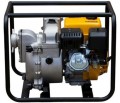Maximum performance
The maximum volume of water that the device can pump in a certain amount of time. It is one of the key specs of any pump because characterizes the volume of water with which the device can work. At the same time, it does not always make sense to pursue maximum performance — after all, it significantly affects the dimensions and weight of the unit.
Some formulas allow you to derive optimal performance values for different situations. So, if the pump is designed to supply water to water intake points, its minimum required performance should not be lower than the highest total flow rate; if desired, a margin of 20-30% can be added to this value. And for sewer models (see "Suitable for"), everything will depend on the volume of wastewater. More detailed recommendations for choosing a pump depending on performance can be found in special sources.
Maximum head
The maximum head generated by the pump. This parameter is most often indicated in meters, by the height of the water column that the unit can create — in other words, by the height to which it can supply water. You can estimate the pressure created by the pump using a simple formula: every 10 m of head corresponds to a pressure of 1 bar.
It is worth choosing a pump according to this parameter, taking into account the height to which it should supply water, as well as adjusting for losses and the need for pressure in the water supply. To do this, it is necessary to determine the difference in height between the water level and the highest point of water intake, add another 10 to 30 m to this figure (depending on the pressure that needs to be obtained in the water supply), and multiply the result by 1.1 — this will be the minimum pressure required.
Outlet size
The thread size for connecting a hose or pipe to the pump outlet. If there is a branch pipe with an external thread in the design, the size is indicated for it; if not, for the internal thread of the inlet.
Anyway, the dimensions of the pump outlet and the mounts on the hose/pipeline connected to it must match — otherwise, you will have to look for adapters. This size is specified in inches and fractions of an inch.
This parameter is relevant primarily for surface models.
Inlet hole size
The size of the thread designed to connect the pump to the suction line. This parameter is completely similar to the size of the outlet (see above) — in particular, it can be specified both for the nozzle and for the inlet of the pump.
Maximum power
Rated power of the pump motor. The more powerful the engine, the higher the performance of the unit, usually, the greater the pressure, suction height, etc. Of course, these parameters largely depend on other features (primarily the pump type, see above); but models similar in design can be compared in terms of power.
Note that high power, usually, increases the size, weight and cost of the pump, and also implies high costs of electricity or fuel (see "Power source"). Therefore, it is worth choosing a pump according to this parameter taking into account the specific situation; more detailed recommendations can be found in special sources.
Engine specifications
The main characteristics of the internal combustion engine (see "Power") installed in the motor pump. This paragraph may include, in particular, the following points:
— Volume. The working volume of the cylinder (cylinders) of the engine. Larger displacement generally provides more power, but fuel consumption rises accordingly.
— Power. The power of gasoline and diesel engines is traditionally indicated in horsepower. The meaning of this parameter is the same as that of the nominal power (see above), indicated in watts. And some units can be easily converted into others: 1 hp. approximately equal to 735 watts. However, the designation in horsepower is more convenient for evaluating and comparing internal combustion engines.
— The number of cycles. In modern units with internal combustion engines, including motor pumps, 2-stroke or 4-stroke engines can be used. The first option is characterized by higher power and lower cost; its disadvantages are a high noise level and the need to refuel with a fuel-oil mixture, which is not very convenient. 4-stroke internal combustion engines are quite complex in design and expensive, but they are easier to operate, and they make less noise. Note that most 2-stroke engines are gasoline, diesel engines of this type are practically not found today.
— The number of cylinders. The presence of several cylinders contributes to the uniform rotation of the motor shaft. On the other hand, this feature signific...antly affects the size and weight, while uniformity for pumps is not critical. Therefore, the vast majority of engines in modern motor pumps are single-cylinder.
— Launch method. The engine can be started both manually and with an electric starter. For the first method, see above; manual start is more difficult (usually you need to pull a special cable with considerable effort, often several times), but it is more reliable, because. does not depend on the battery.
— Cooling type. In modern internal combustion engines, two types of cooling are used — liquid (water) and air. Specifically, in motor pumps, the vast majority of devices use the second option, because. air systems are much simpler and cheaper, and their efficiency, although lower than that of water systems, is still quite sufficient.

